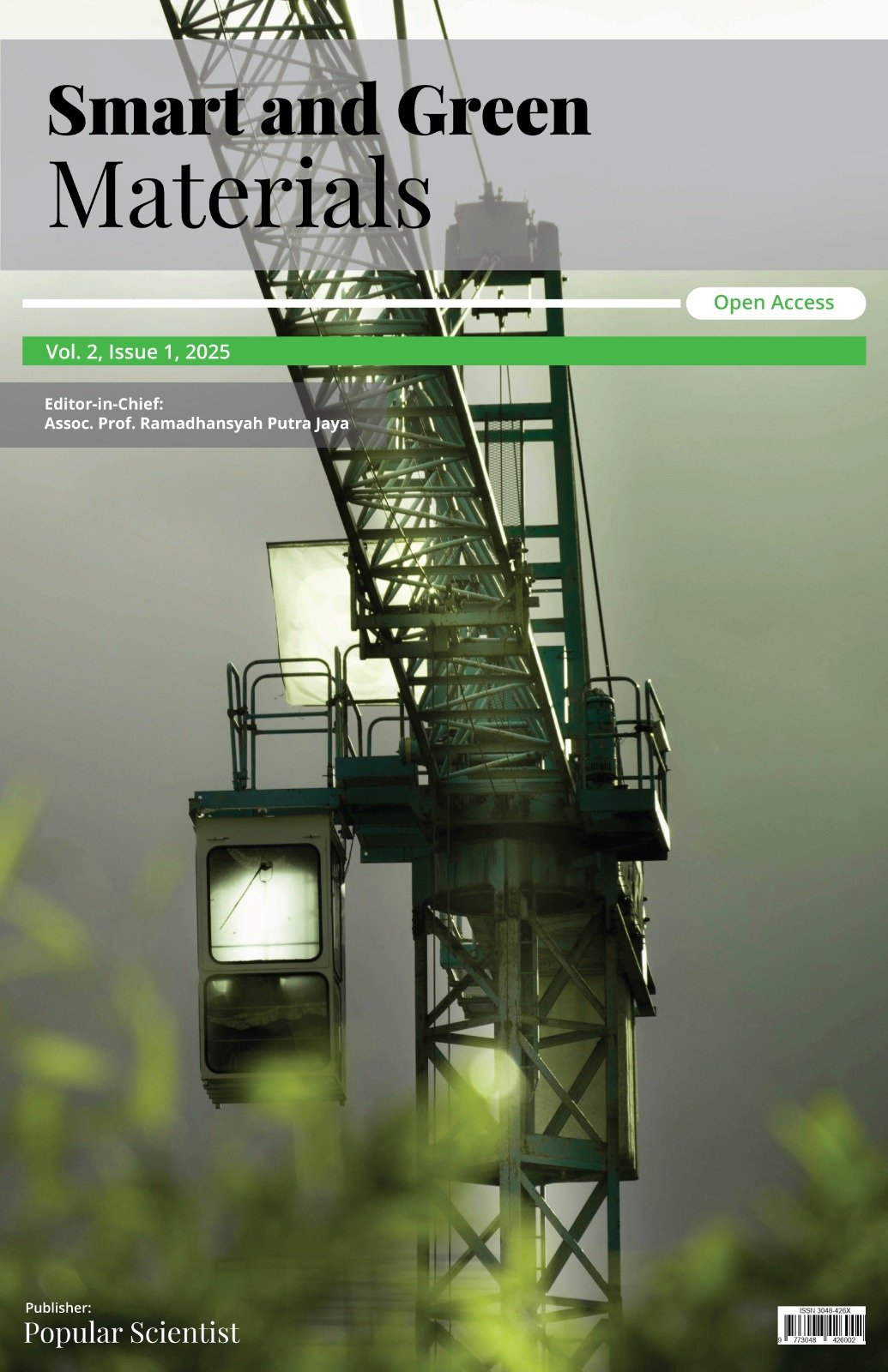Limestone Powder in Concrete Mixes: A Review of Mechanical Enhancements
DOI:
https://doi.org/10.70028/sgm.v2i1.25Keywords:
Limestone, Powder, Concrete, Sustainable Solution, Construction MaterialAbstract
The wide application of concrete as a construction material is also connected with a large environmental impact, mainly related to CO2 emissions from the production of Portland cement. Hence, studies increasingly investigate alternative materials that could substitute concrete, mitigating its impacts on the environment without losing its mechanical performance. Limestone powder has recently been highly considered as a supplementary constituent of concrete. This review focuses on the effects of LS on the compressive, tensile, flexural strength, and elastic modulus of concrete. Data show that it is highly affected by factors like the size of particles, dosage, and the method of application of LS in relation to its impacts on the mechanical properties of concrete. Specifically, finer LS particles can improve the compressive strength of concrete by filling the gaps and providing nucleation sites for hydration products. However, high LS concentration can cause a diluting effect that reduces compressive strength. On the other hand, LS may improve elastic modulus, tensile, and flexural strength when combined with other wastes like marble waste aggregate. These observations have explicated that LS is a workable and sustainable addition in view of performance improvement in concrete.
Downloads
References
P. K. . M. Mehta Paulo J.M., Concrete: Microstructure, Properties, and Materials, 2005.
S. H. Mahi et al., “Ceramic Waste as A Sustainable Building Material: A Comprehensive Review,” in 7th International Conference on Advances in Civil Engineering (ICACE2024), 2024, pp. 1769–1776.
WBCSD, “The cement sustainability initiative: recycling concrete,” 2009.
K. P. Mehta, “Reducing the Environmental Impact of Concrete,” Concr. Int., vol. 23, no. 10, pp. 61–66, 2001.
WBCSD-CSI, “Cement Industry Energy and CO2 Performance ‘Getting the Numbers Right,’” Washington, DC, 2009.
IEA-WBCSD, “Cement Technology Roadmap 2009 – Carbon emissions reductions up to 2050,” 2009.
C. D. Tomkins and G. Throwdown, Redefining what’s possible for clean energy by 2020. San Francisco., 2009.
V. M. Malhotra and P. K. Mehta, High performance, high-volume fly ash concrete for building sustainable and durable structure. 2008.
P. K. C. Mehta P; Naik, T R, “Sustainable Cements and Concrete for the Climate Change Era - A Review,” NA, vol. NA, no. NA. p. NA-NA, 2010.
D. S. Wang Caijun; Farzadnia, Nima; Shi, Zhenguo; Jia, Huangfei; Ou, Zhihua, “A review on use of limestone powder in cement-based materials: Mechanism, hydration and microstructures,” Constr. Build. Mater., vol. 181, no. NA, pp. 659–672, 2018, doi: http://dx.doi.org/j.conbuildmat.2018.06.075
I. Soroka and N. Stern, “Calcareous fillers and the compressive strength of portland cement,” Cem. Concr. Res., vol. 6, no. 3, pp. 367–376, 1976, doi: http://dx.doi.org/10.1016/0008-8846(76)90099-5
V. B. Bosiljkov, “SCC Mixes With Poorly Graded Aggregate And High Volume Of Limestone Filler,” Cem. Concr. Res., vol. 33, no. 9, pp. 1279–1286, 2003, doi: http://dx.doi.org/10.1016/s0008-8846(03)00013-9
N. S. Ghafoori Rebecca; Najimi, Meysam, “Influence of limestone size and content on transport properties of self-consolidating concrete,” Constr. Build. Mater., vol. 127, no. NA, pp. 588–595, 2016, doi: http://dx.doi.org/10.1016/j.conbuildmat.2016.10.051
L. M. Courard Frédéric; Pierard, Julie, “Influence of clay in limestone fillers for self compacting cement based composites,” Constr. Build. Mater., vol. 25, no. 3, pp. 1356–1361, 2011, doi: http://dx.doi.org/10.1016/j.conbuildmat.2010.09.009
A. A. G. Ramezanianpour Ebrahim; Nickseresht, I.; Mahdikhani, ; Moodi, Faramarz, “Influence of various amounts of limestone powder on performance of Portland limestone cement concretes,” Cem. Concr. Compos., vol. 31, no. 10, pp. 715–720, 2009, doi: http://dx.doi.org/10.1016/j.cemconcomp.2009.08.003
G. İ. Sezer, “Compressive strength and sulfate resistance of limestone and/or silica fume mortars,” Constr. Build. Mater., vol. 26, no. 1, pp. 613–618, 2012, doi: http://dx.doi.org/10.1016/j.conbuildmat.2011.06.064
M. S. L. Meddah Mukesh C.; Dhir, Ravindra K., “Potential use of binary and composite limestone cements in concrete production,” Constr. Build. Mater., vol. 58, no. NA, pp. 193–205, 2014, doi: http://dx.doi.org/10.1016/j.conbuildmat.2013.12.012
L. G. . K. Li Albert K.H., “Adding limestone fines as cementitious paste replacement to improve tensile strength, stiffness and durability of concrete,” Cem. Concr. Compos., vol. 60, no. NA, pp. 17–24, 2015, doi: http://dx.doi.org/10.1016/j.cemconcomp.2015.02.006
I. M. . B. Nikbin M.H.A.; Kazemi, Mohammad; Amiri, J. Vaseghi; Rabbanifar, Saeed; Rahmani, E.; Rahimi, S., “A comprehensive investigation into the effect of water to cement ratio and powder content on mechanical properties of self-compacting concrete,” Constr. Build. Mater., vol. 57, no. NA, pp. 69–80, 2014, doi: http://dx.doi.org/10.1016/j.conbuildmat.2014.01.098
L. Zhao, T. He, M. Niu, X. Chang, L. Wang, and Y. Wang, “Effect of Limestone Powder Mixing Methods on the Performance of Mass Concrete,” Materials (Basel)., vol. 17, no. 3, pp. 1–16, 2024, doi: http://dx.doi.org/10.3390/ma17030617
P. C. Pliya Duncan, “Limestone derived eggshell powder as a replacement in Portland cement mortar,” Constr. Build. Mater., vol. 95, no. NA, pp. 1–9, 2015, doi: http://dx.doi.org/10.1016/j.conbuildmat.2015.07.103
P. Livesey, “Strength characteristics of Portland-limestone cements,” Constr. Build. Mater., vol. 5, no. 3, pp. 147–150, 1991, doi: http://dx.doi.org/10.1016/0950-0618(91)90065-s
T. L. Schmidt Barbara; Romer, Michael; Neuenschwander, Jürg; Scrivener, Karen, “Physical and microstructural aspects of sulfate attack on ordinary and limestone blended Portland cements,” Cem. Concr. Res., vol. 39, no. 12, pp. 1111–1121, 2009, doi: http://dx.doi.org/10.1016/j.cemconres.2009.08.005
W. H. Li Zhengyu; Cao, Fangliang; Sun, Zhihui; Shah, Surendra P., “Effects of nano-silica and nano-limestone on flowability and mechanical properties of ultra-high-performance concrete matrix,” Constr. Build. Mater., vol. 95, no. 95, pp. 366–374, 2015, doi: http://dx.doi.org/10.1016/j.conbuildmat.2015.05.137
L. Wenyu and Z. Zhihui, “Study on high-strength concrete made with fine limestone powder,” Open Constr. Build. Technol. J., vol. 9, no. 1, pp. 21–26, Jul. 2015, doi: http://dx.doi.org/10.2174/1874836801509010021
S. Harmandeep and S. Lovneesh, “Effect of Limestone Waste Powder and Marble Waste over the Strength Properties of the Conventional Concrete,” IOP Conf. Ser. Earth Environ. Sci., vol. 1110, no. 1, 2023, doi: http://dx.doi.org/10.1088/1755-1315/1110/1/012077
P. Singniao, M. Sappakittipakorn, and P. Sukontasukkul, “Effect of silica fume and limestone powder on mechanical properties of ultra-high performance concrete,” IOP Conf. Ser. Mater. Sci. Eng., vol. 897, no. 1, Aug. 2020, doi: http://dx.doi.org/10.1088/1757-899X/897/1/012009
B. S. Saini and S. P. Singh, “Flexural fatigue strength prediction of self compacting concrete made with recycled concrete aggregates and blended cements,” Constr. Build. Mater., vol. 264, Dec. 2020, doi: http://dx.doi.org/10.1016/j.conbuildmat.2020.120233
Y. Subramaniyan, J. Baskaran, and N. K. Krishnaswami, “Utilization of Industrial Wastes in Manufacture of Self Compacting Concrete and Examining Its Flexural Behaviour,” IOP Conf. Ser. Mater. Sci. Eng., vol. 955, no. 1, Nov. 2020, doi: http://dx.doi.org/10.1088/1757-899X/955/1/012044
A. Radović, V. Carević, A. Radević, B. Stupar, and D. Veličkov, “Influence of curing period on some mechanical and durability-related properties of limestone powder concrete,” Gradjevinski Mater. i Konstr., no. 00, pp. 20–20, 2024, doi: http://dx.doi.org/10.5937/GRMK2400007R
J. Liu, S. Song, Y. Sun, and L. Wang, “Influence of Ultrafine Limestone Powder on the Performance of High Volume Mineral Admixture Reactive Powder Concrete,” Adv. Mater. Res., vol. 152–153, pp. 1583–1586, 2011, doi: http://dx.doi.org/10.4028/www.scientific.net/AMR.152-153.1583
S. Hesami, A. Modarres, M. Soltaninejad, and H. Madani, “Mechanical properties of roller compacted concrete pavement containing coal waste and limestone powder as partial replacements of cement,” Constr. Build. Mater., vol. 111, pp. 625–636, 2016, doi: http://dx.doi.org/10.1016/j.conbuildmat.2016.02.116
G. D. Moon, S. Oh, S. H. Jung, and Y. C. Choi, “Effects of the fineness of limestone powder and cement on the hydration and strength development of PLC concrete,” Constr. Build. Mater., vol. 135, pp. 129–136, Mar. 2017, doi: http://dx.doi.org/10.1016/j.conbuildmat.2016.12.189
B. K. Mohammed and B. S. Al-Numan, “Effectiveness of Limestone Powder as a Partial Replacement of Cement on the Punching Shear Behavior of Normal- and High-Strength Concrete Flat Slabs,” Sustainability, vol. 16, no. 5, Mar. 2024, doi: http://dx.doi.org/10.3390/SU16052151
A. N. Ede, O. M. Olofinnade, O. Joshua, D. O. Nduka, and O. A. Oshogbunu, “Influence of bamboo fiber and limestone powder on the properties of self-compacting concrete,” Cogent Eng., vol. 7, no. 1, Jan. 2020, doi: http://dx.doi.org/10.1080/23311916.2020.1721410
Z. Adel Mohammed, R. Burhan Abdurrahman, and D. Abdul Hakeem Hamed Ahmad, “Influence of Limestone Powder as Partial Replacement of Cement on Concrete and the Effect of High Temperature on It,” AL-Rafdain Eng. J., vol. 18, no. 5, pp. 24–34, 2010, doi: http://dx.doi.org/10.33899/rengj.2010.32863
D. Rajawat, S. Siddique, S. Shrivastava, S. Chaudhary, and T. Gupta, “Influence of fine ceramic aggregates on the residual properties of concrete subjected to elevated temperature,” Fire Mater., vol. 42, no. 7, pp. 834–842, 2018, doi: http://dx.doi.org/10.1002/fam.2639
D. Wang, C. Shi, N. Farzadnia, Z. Shi, and H. Jia, “A review on effects of limestone powder on the properties of concrete,” Constr. Build. Mater., vol. 192, pp. 153–166, 2018, doi: http://dx.doi.org/10.1016/j.conbuildmat.2018.10.119
P. Silva and J. de Brito, “Experimental study of the mechanical properties and shrinkage of self-compacting concrete with binary and ternary mixes of fly ash and limestone filler,” Eur. J. Environ. Civ. Eng., vol. 21, no. 4, pp. 430–453, 2017, doi: http://dx.doi.org/10.1080/19648189.2015.1131200
Downloads
Published
Issue
Section
License
Copyright (c) 2025 Md. Saniul Haque Mahi, Tanjun Ashravi Ridoy, Md. Faiag Ahmed Nibir, Mohummad Shopon Sheikh (Author)

This work is licensed under a Creative Commons Attribution-NonCommercial 4.0 International License.













